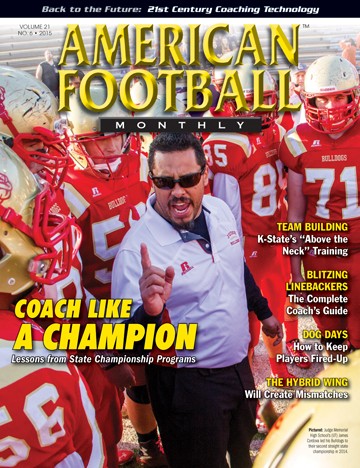Coaching the Blitzing Linebacker – Learning the proper progressions, techniques, and then drills for a blitzing linebacker will improve his performance on game day.
by: Kyle SchenkDefensive Coordinator Malone University©
More from this issue
Attacking with linebackers and slanting the defensive linemen creates an opportunity to be unique and aggressive. Blitzing linebackers creates opportunities to change the defense into an over or under defense after the snap. When this is done with the 3-3-5 stack alignment, there is flexibility to match offensive numbers or be balanced at all times.
What makes a linebacker effective in a swarm and strike defense?
Recruiting linebackers to fit your defense takes great attention to detail in both the tangibles and the intangibles. To find the tangibles of a great linebacker, there are six tests used for every potential scholarship player. The tests are the 20-yard dash, pro agility drill, and broad jump along with their height, weight and wingspan. Film evaluation is an important tool, but when paired with the testing, it creates a more complete picture.
Focus on recruiting leaders who are smart on and off the field. Recruit athletes who would fit in your own home and be part of your family. One of the unique characteristics of our program is the importance of recruiting players with strong character and integrity. Search for linebackers who will lead others to do the right thing when no one is looking. A football team is a family and it is built on trust. No one wants an untrustworthy person in the locker room.
Blitz Technique Simplification
Simplification should be the first step when developing a blitzing defense. The linebackers’ entire role on defense can be summed up in five to nine techniques. Simplification enables players to spend the majority of the individual drill work on the things they will do the majority of the time.
Three of those techniques for the linebackers are our blitzing techniques. Creating three types of blitzes, with the possibility of hundreds of combinations, enables a defense to be technical, fast, and creative. Stay simple in the run assignments. Aiming points on the quarterback are used instead of pass rush lanes. Here is an example of tools used to simplify blitzing assignments and techniques (Diagrams 1 and 2).
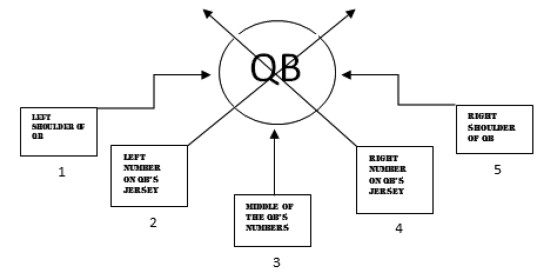

Installing the Blitz
When installing a new technique, we use the same method of teaching. The big picture concept is first presented by the defensive coordinator in the defensive meeting with an overview of the technique. Then the defense has an understanding of each position and how each position works toward the ultimate goal. The best way to educate is through player engagement and this method is a great way to start the conversation.
Everyone communicates and learns differently, so I encourage the players to ask questions so they can grasp the concept. During the defensive meeting we discuss run fits and pass assignments and try to explain why we are doing this specific install and what scenario I like to call this defense. When the players understand the background of a specific play, they will understand their role on a deeper and more accurate level.
From there, we move into the detailed install plan and split into position groups. The position coach then elaborates on all the details of the install. It is crucial that all the coaches and players use the same terminology to facilitate cross position communication. Finally, the defense returns to the big picture concept with film review and install walk through.
Coaching Blitzing Linebackers
The following is an example of the progression we use to teach a linebacker how to blitz. The specific blitz illustrated is titled “Storm” and is a common blitz for our defense. The progression is used during practice to delve into the details of the blitz.
Storm Blitz Run Fits
The stack linebacker will key the outside hip of the tackle and his run assignment will be squeeze/spill. The Mike has the A gap but if the ball moves past him because of the wash from the end, he will scrape (Diagram 3). When we talk about run fits there are eight run fits to every play and the entire defense knows what they are and what they mean.
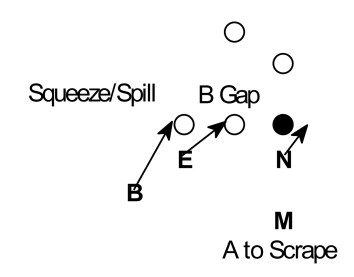
Storm Blitz Coaching Progression:
1. Hip to Hip Drill
The Hip to Hip drill uses an offensive lineman who moves at different paces and angles, but always as a down block. The stack linebacker will try to time his movement so that he is blitzing right before the offensive tackle moves. His goal is to touch the offensive tackle’s outside hip with his inside hip (Diagram 4).

2. Beat the Base Drill
This is the second phase of the hip to hip drill, but now the tackle is given the chance to step out to the linebacker in a reach block or a base block. The linebacker wants to attack and create separation with his hips open to the sideline. The mistake many linebacekers make is to take themselves out of the play by attacking too far upfield. They must learn to stay and fight pressure. Occasionally a linebacker can defeat the hands and step on the heels of the tackle. But the ultimate goal is to attack the tackle (Diagram 5).
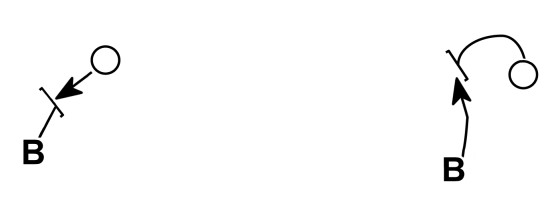
3. Step on the Heels Drill (Diagram 6)

The purpose of the Step on the Heels Drill is to emphasize keeping the hips open to the sidline without a second level block. Again, this is a progression from the Hip to Hip drill. After he gets hip to hip, the stack linebacker must plant his inside foot behind the outside hip of the tackle. This naturally places his inside foot forward and his outside foot back. This results in optimal “open” position and allows him an opportunity to read the mesh.
4. Second Level Block Drill (Diagram 7)

In this drill, the emphasis is eye progression from the hip to what we call a second level block. A second level block is a back, H back, or pulling lineman that is attacking the blitzer. This drill begins like the Step on the Heels Drill except the blitzing linebacker has to quickly transition his eyes to check for a second level block while still getting hip to hip.
If the linebacker identifies the tight path of the second level block, he becomes a primary spill player by working to the inside hip of the second level block and pressing hard upfield. Pad level is extremely important on all spills and this drill is performed in the chutes if needed. If there is no second level block, they revert back to the Step on the Heels Drill.
5. Second Level Arc Drill
The goal of the defense is to stop the run first and keep it simple. Therefore, this drill is not used as frequently because of the need to stop the run and players should err on the side of spilling.
This is set up exactly like the Second Level Block Drill except now there is an additional playside guard and the tackle has the option to arc block or kick out with the playside guard or second level block. If the linebacker encounters an arc block, he must fight hard to keep contain for lane 1 or 5. This is the last drill we progress to before including defensive linemen (Diagram 8).
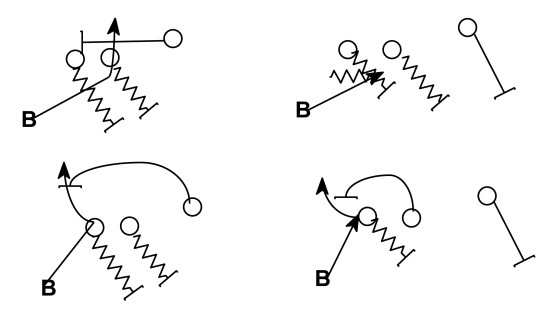
6. Half Line Blitz Fits
The previous five drills are performed with the linebacker postion group. The Half Line Blitz Fits progress to include a defensive end and a nose tackle. Additionally, a coach will run the scout team and simulate plays from the opponent’s offense. This is an important drill because it is a stepping stone to the inside run drill and it helps coaches ensure correct technique and fits at the point of attack (Diagram 9).
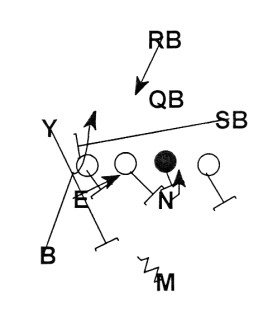
Full Team
In the final progression, the drill is tacken to the biggest component of football, playing the game. A full defense and offense is included. Coaching is done through film review and allowing the players to play and practice what they have learned. The coaches strive to limit the mistakes by developing a great progression (see, hear, practice, perform) in the teaching.
Pass Rush
In our swarm and strike defense, the goal of pass rushing is to beat the edge when in contain and to penetrate on any other blitz where contain is not their responsibility. For this illustration, the blitz “Storm” will once again be detailed. First, survey each linebackers ability and their natural capabilities will determine how many moves they are allowed to use. Typically, in this defense, each linebacker receives one speed rush progression and a counter.
Get offs
Players need to practice timing the quarterback’s cadence. This is to ensure the linebacker learns to move just before the snap, allowing him time to read the EMOL. It is as simple as a coach calling a count and snapping the ball. It is preferable to run this drill with a scout quarterback, but it can be performed with a coach calling the count. Analyzing quarterback body language in film is another way we prepare the linebackers to time up the blitz.
Inside Run
This drill involves all positions on the offense and defense except corners and wide recievers. Inside Run progesses differently than most because of the numerous blitzes and the front movements we incorporate. Each play is run two times consecutively against a scout team. One play with the run on the blitz side and the next play away from the blitz (Diagram 10).

Small Hoop Drills
One of our defense’s favorite pass rush drills is the Small Hoop Drill. Our small hoop is a PVC connected at the ends with a circumference of 10 feet. This drill simulates a true lane because you can practice outside and inside rush moves while staying in your lane (Diagram 11).
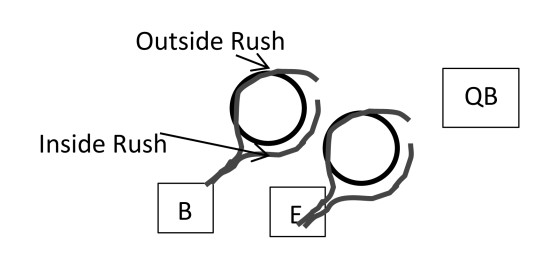
One on One Pass Rush
In this defense, it is important for the linebackers to rush against offensive linemen, so they spend part of practice with the defensive line working on one-on-one pass rushing. If given the opportunity to work against offensive linemen, we want to imagine a tick tac toe board on his chest and only attack the outside bottom two sections. Diagram 12 illustrates how the linebackers should attack the weakest part of the offensive linemen (outsides of section 2 and 3). The linebackers are instructed to never attack the inside 1/3 of the offensive linemen . This diagram helps them to understand the offensive lines weakest points and the most effective attack points.
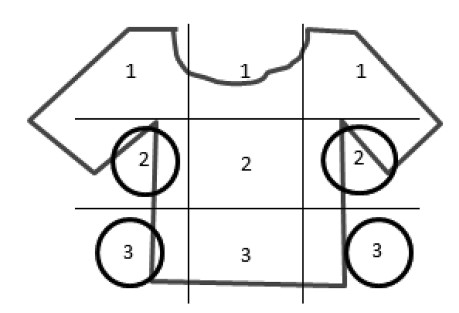
Tag Team
The Tag Team Drill was created for multiple purposes. This drill allows the offense to work on their pass protection and the defense to work on their blitz combinations without a large amount of contact. This drill also allows the defensive linemen and linebackers to work cooperatively to get pressure as a “tag team”. In this drill, there are three to four offensive linemen and a running back against one defensive lineman and one linebacker. The idea is for the offense to use any protection they want, but to end up three-on-two. The defensive players begin to understand protections and how to attack them. Also, the defensive players can improve teamwork and gain confidence that two defensive players can beat three offensive players (Diagram 13).

We coach our players hard and we are always striving to improve their techniques. Football is fun and we do our best to instill that philosophy in our team, but nothing is more fun than playing great football.
About the Author:
Kyle Schenk has completed five full seasons as Malone University’s defensive coordinator. It is his second stint at Malone after coaching linebackers for the 2007 season. Schenk was the special teams coordinator at Sterling College in 2008 and 2009 and has also coached at Greenville College, Taylor University and Trinity International University. A four-year starter at linebacker at TIU, Schenk received his Bachelor’s Degree in 2003. He also received his Master’s from Greenville in 2008.
